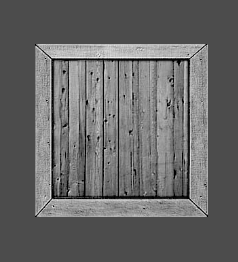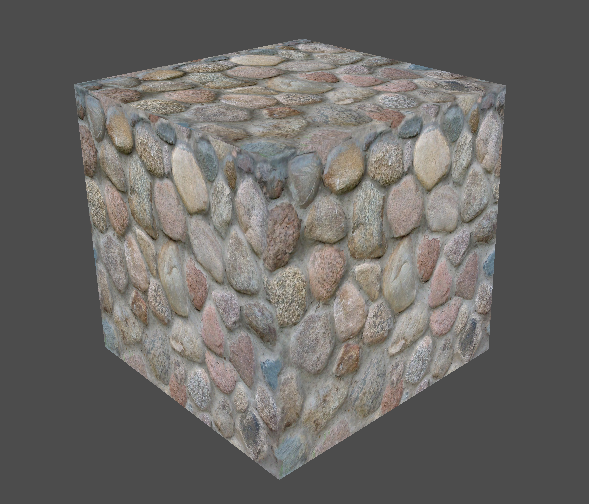MeshVertex
VertexTextureNormal(float x, float y, float z, float u, float v, float nx, float ny, float nz)
{
Position = Vector3(x, y, z);
Uv = Vector2(u, v);
Normal = Vector3(nx, ny, nz);
}
이러한 구조체이다.
Quad
게임 엔진에서 지형으로 많이 사용하는 물체이다. 한쪽에서만 보이는 물체이다.
MeshQuad.h
#pragma once
class MeshQuad : public Mesh
{
public:
MeshQuad(Shader* shader);
~MeshQuad();
private:
void Create() override;
};
간단하다 일단 만드는 부분만 있다.
MeshQuad.cpp
#include "Framework.h"
#include "MeshQuad.h"
MeshQuad::MeshQuad(Shader * shader)
: Mesh(shader)
{
}
MeshQuad::~MeshQuad()
{
}
void MeshQuad::Create()
{
float w = 0.5f;
float h = 0.5f;
vector<MeshVertex> v(4);
v[0] = MeshVertex(-w, -h, 0, 0, 1, 0, 0, -1);
v[1] = MeshVertex(-w, +h, 0, 0, 0, 0, 0, -1);
v[2] = MeshVertex(+w, -h, 0, 1, 1, 0, 0, -1);
v[3] = MeshVertex(+w, +h, 0, 1, 0, 0, 0, -1);
vertices = new MeshVertex[v.size()];
vertexCount = v.size();
copy(v.begin(), v.end(), stdext::checked_array_iterator<MeshVertex *>(vertices, vertexCount));
indexCount = 6;
indices = new UINT[indexCount]{ 0, 1, 2, 2, 1, 3 };
}
그냥 간단하다 한쪽 면만 그려주면 된다.
뒷면은 안보인다. 안보여서 찍어봤자 의미 없어서 사진은 없다.
Cube
큐브이다. 만드는 방법을 생각하면 각 위치에서 보이는 Quad를 6개 만든것이다.
Cube.h
#pragma once
class MeshCube : public Mesh
{
public:
MeshCube(Shader* shader);
~MeshCube();
private:
void Create() override;
};
비슷하다.
Cube.cpp
void MeshCube::Create()
{
float w = 0.5f;
float h = 0.5f;
float d = 0.5f;
vector<MeshVertex> v(24);
// front
v[0] = MeshVertex(-w, -h, -d, 0, 1, 0, 0, -1);
v[1] = MeshVertex(-w, +h, -d, 0, 0, 0, 0, -1);
v[2] = MeshVertex(+w, +h, -d, 1, 0, 0, 0, -1);
v[3] = MeshVertex(+w, -h, -d, 1, 1, 0, 0, -1);
// back
v[4] = MeshVertex(-w, -h, +d, 1, 1, 0, 0, 1);
v[5] = MeshVertex(+w, -h, +d, 0, 1, 0, 0, 1);
v[6] = MeshVertex(+w, +h, +d, 0, 0, 0, 0, 1);
v[7] = MeshVertex(-w, +h, +d, 1, 0, 0, 0, 1);
//top
v[8] = MeshVertex(-w, +h, -d, 0, 1, 0, 1, 0);
v[9] = MeshVertex(-w, +h, +d, 0, 0, 0, 1, 0);
v[10] = MeshVertex(+w, +h, +d, 1, 0, 0, 1, 0);
v[11] = MeshVertex(+w, +h, -d, 1, 1, 0, 1, 0);
// bottom
v[12] = MeshVertex(-w, -h, -d, 1, 1, 0, -1, 0);
v[13] = MeshVertex(+w, -h, -d, 0, 1, 0, -1, 0);
v[14] = MeshVertex(+w, -h, +d, 0, 0, 0, -1, 0);
v[15] = MeshVertex(-w, -h, +d, 1, 0, 0, -1, 0);
// left
v[16] = MeshVertex(-w, -h, +d, 0, 1, -1, 0, 0);
v[17] = MeshVertex(-w, +h, +d, 0, 0, -1, 0, 0);
v[18] = MeshVertex(-w, +h, -d, 1, 0, -1, 0, 0);
v[19] = MeshVertex(-w, -h, -d, 1, 1, -1, 0, 0);
// right
v[20] = MeshVertex(+w, -h, -d, 0, 1, 1, 0, 0);
v[21] = MeshVertex(+w, +h, -d, 0, 0, 1, 0, 0);
v[22] = MeshVertex(+w, +h, +d, 1, 0, 1, 0, 0);
v[23] = MeshVertex(+w, -h, +d, 1, 1, 1, 0, 0);
vertices = new MeshVertex[v.size()];
vertexCount = v.size();
copy(v.begin(), v.end(), stdext::checked_array_iterator<MeshVertex *>(vertices, vertexCount));
indexCount = 36;
indices = new UINT[indexCount]
{
0, 1, 2, 0, 2, 3,
4, 5, 6, 4, 6, 7,
8, 9, 10, 8, 10, 11,
12, 13, 14, 12, 14, 15,
16, 17, 18, 16, 18, 19,
20, 21, 22, 20, 22, 23
};
}
다른부분은 특별히 다른점이 없기 때문에 Create부분만 설명한다.
천천히 살펴보자
- 앞면
- Quad했던것처럼 두르기 순서로 그리면 된다. 어차피 뒷에서는 뒷면에 가려서 안보일거니까
- UV도 왼쪽 위를 생각하면서 뒤집어 주면 된다.
- Normal 앞면이니까 앞으로 향하게 한다.
- 뒷면
- Y축으로 뒤집에서 그려주자 그러면 왼아, 오아, 오위, 왼위 로 그려진다. 이때 뒤집어서 본다 하면 그려지는 순서는 오아, 오위, 왼위, 왼아 순으로 그려진다.
- UV도 위에처럼 Y축으로 뒤집어주자
- Normal 뒷면이니까 뒤로 향하게 해주자
- 윗면
- z축을 생각해야 한다. 왼쪽 뒤, 왼앞, 오앞, 왼앞 으로 그려준다. 이렇게 그려주고 위를 보면 앞면이랑 같은 순서로 그려준다.
- UV는 그려주는 순서대로 앞면과 똑같이 해준다.
- Normal은 위로 향하니까 y축으로 향해주자
- 뒷면
- 왼쪽 앞, 오앞, 오뒤, 왼뒤 이 방향으로 그려준다. 그리고 밑을 보면 앞면과 같은 순서로 그려준다.
- UV도 뒷면과 똑같이 해준다.
- Normal은 밑을 향하니까 y축 반대로 해주자
- 왼쪽면
- 아뒤, 위뒤, 위앞, 아앞 이 순으로 그려준다.
- UV도 이거에 맞춰 펴주자
- Normal은 왼쪽을 향하니까 x축 반대로 해주자
- 오른쪽면
- 아앞, 위앞, 위뒤, 아뒤 이 순서로 그려준다.
- UV도 맞춰 펴주자
- Normal은 오른쪽을 향하니까 x축으로 해주자
IndexBuffer는 각 면이 같으니까 한쪽면의 4만큼 더해서 해주자.
이렇게 하면,
큐브가 잘 나온다.

